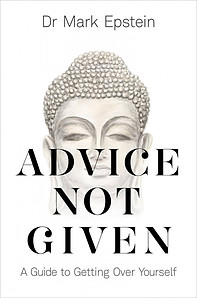Book – Advice not given (A Guide to getting over yourself) (Summary)
Author – Dr. Mark Epstein
Published in – 2018
“Praise and blame, gain and loss, pleasure and sorrow come and go like the wind. Rest like a giant tree in the midst of them all to be happy.” – Buddha.
As mentioned in the book – Awakening does not make the ego disappear; it changes one’s relationship with it. The balance of power shifts, but there is still work to do. Rather than being driven by selfish concerns, one must take personal responsibility for them.
About the Author –
Dr. Mark Epstein, an American Author, has integrated psychotherapy with Buddhist teaching in handling ego, trauma, and how to lead a more balanced life. He has also written a few more books on trauma, The Trauma of Everyday Life Thoughts without a Thinker: Psychotherapy from a Buddhist Perspective, to name a few.
About the Book –
Advice not given discusses ways of handling the Ego from Western psychotherapy (Quoting Sigmund Freud mainly) and Buddhism’s point of View. It conveys similarities between both forms of taking the ego and how to utilize it to our advantage rather than being used by it.
In Buddhism, this engagement with the ego is described as the path to enlightenment and the way out of it. It is traditionally explained as an Eightfold Path: Right View, Right Motivation, Right Speech, Right Action, Right Livelihood, Right Effort, Right Mindfulness, and Right Concentration.
The Eightfold Path is a means of orienting yourself so that your fears and habits do not tip the balance of your existence.
Highlights of a few paths out of Eight Paths
1) Right View –
- We often look at things and conclude what we see after adding our judgment to it. Buddhism and psychotherapy suggest observing without judgment and not counting our stories with what we see to deal with it effectively.
- Right View states that the fundamental purpose of Buddhist meditation is not to create a comfortable hiding place for oneself but to acquaint the mind with impermanence on a moment-to-moment basis.
- Right View was the Buddha’s method of describing a realistic way of responding to the truth of impermanence.
3) Right Speech –
- How we talk to ourselves is as important as how we speak to others. The way we think is as crucial as what we say out loud.
- What we speak with others is as important as how we talk to ourselves, stories we keep repeating beneath our breaths, and often what we think is incorrect.
Loved the Interpretation of Right Speech in this paragraph –
“Right Speech, in my interpretation, asks us to pay attention to how we talk to ourselves about this inevitable aspect of life and how we exaggerate its implications. So often, within the privacy of our inner worlds, we take the difficult thing and make it worse. Our subliminal hate speech coats our experience and gives an added meaning to things that are already difficult enough. Right Speech says this is unnecessary.”
3) Right Action –
- An enormous amount of restraint is required even while much is needed. Postponing the ego’s need for immediate gratification is the core principle of this aspect of the right action.
4) Right Livelihood –
- Right Livelihood, while encouraging us to reflect upon how we make our money and how we structure our lives, can also help us question our inherent sense of privilege.
- While questioning our vocation, Buddha suggests that a householder should seek four kinds of happiness—”ownership, wealth, restlessness and blamelessness.”
5) Right Effort –
- Right effort are those which liberates one rather than exhaust one. Irrespective of any work, be it physical or mental.
- When one is in tune with his work (also called flow state) and loves his career, he tends to get the best result with less exertion. One must find the balance, as forcing oneself on work or letting it loose will have adverse effects.
6) Right Mindfulness –
- Dr. Mark suggests that Mindfulness should be used to get better and not be seen as the ultimate goal, as what we feel is present and things we encounter still have to be faced. It is possible to overvalue Mindfulness, to remain attached to its form rather than working directly with what it reveals.
- Right Mindfulness opens up exciting opportunities for honest self-reflection, but there is no guarantee that these openings will be used productively.
- Developing Mindfulness is like learning to ride a bicycle or walk on a tightrope, only much more frustrating. One keeps falling, even after years and years of effort. Right Mindfulness means having a light touch.
Here are a few Awesome Quotes from the book
1) Making one’s life into meditation differs from using meditation to escape from life.
2) Just as no artist makes work identical to any other, no person’s development will look or feel the same as anyone else’s.
3) You can do anything you want; only your thought that you can’t do it is holding you back. – Dipa Ma
4) In an insecure world, we can become our refuge. Our egos do not have to have the last word.
Conclusion –
Dr. Mark Epstein wonderfully describes all paths with examples of his patients or quoting other real-life experiences of himself or others he has been associated with for a long time.
I learned a new perspective on ego, usual wiring, and stories we keep telling ourselves about our situation. The book took me a step further in investigating those stories, getting over them and myself.
If you like this book, you will also like The Ego is the Enemy.
I hope this book summary helped you in some way. I would appreciate your comments below.
I wish you a wonderful life.
Muzammil


Thanks again for the post.